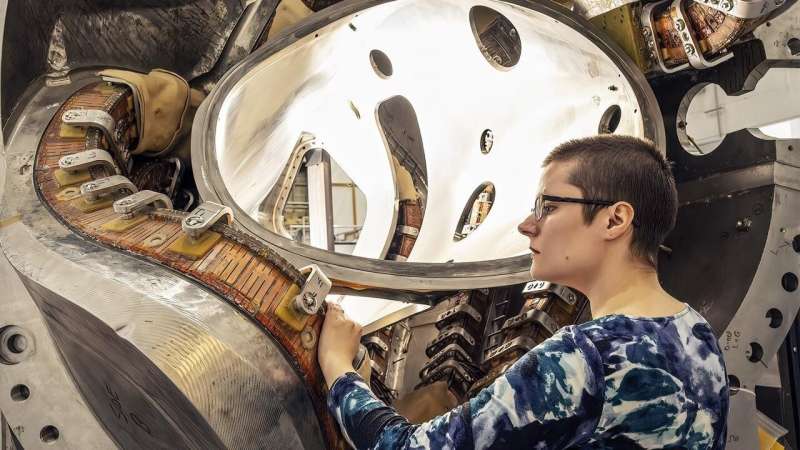by Raphael Rosen, Princeton University

Scientists have found a mathematical shortcut that could help harness fusion energy, a potential source of clean electricity that could mitigate floods, heat waves, and other rising effects of climate change. The method allows researchers to more easily predict how well a stellarator—a twisty device designed to reproduce the fusion energy that powers the sun and stars—can retain the heat crucial to fusion reactions.
The technique measures how well a stellarator’s magnetic field can hold on to the fastest-moving atomic nuclei in the plasma, boosting the overall heat and aiding the fusion reactions. But how can scientists find a shape that holds in as much of the heat as possible?
Finding magnetic cages that hold heat
“We can’t simulate the motions of all the individual particles in all the possible magnetic fields—that would require almost infinite computing power,” said Alexandra LeViness, a graduate student in plasma physics at the U.S. Department of Energy’s (DOE) Princeton Plasma Physics Laboratory (PPPL). “Instead, we have to use a shortcut,” said LeViness, lead author of the paper reporting the results in the journal Nuclear Fusion.
“This research shows that we can find the best magnetic field shape for confining heat by calculating something easier—how far the fast particles drift away from the curved magnetic field surfaces in the center of the plasma,” LeViness said. “This behavior is described by a number known as gamma C, which we discovered consistently corresponds with plasma confinement.”
In effect, the shortcut advances future stellarator research, LeViness said, “because the more fast-moving particles that stay in the center of the plasma, the hotter the fuel and the more efficient the stellarator will be.”

The history and future of fusion
Fusion releases vast amounts of energy by combining light elements in the form of plasma—the hot, charged state of matter composed of free electrons and atomic nuclei that makes up 99% of the visible universe. Scientists around the world are seeking to harness fusion reactions to create a virtually inexhaustible supply of safe and clean power to generate electricity.
PPPL has more than a half-century of experience developing the theoretical scientific knowledge and advanced engineering to enable fusion to power the U.S. and the world. At the same time, the Laboratory has long advanced the basic scientific understanding of the plasma universe from laboratory to astrophysical scales.
Stellarators, developed by PPPL founder Lyman Spitzer in the 1950s, operate without the risk of damaging disruptions that doughnut-shaped fusion devices called tokamaks face. But stellarators have long been unable to hold in the heat as well as tokamaks, which have similar magnetic fields.
“But using techniques like the one LeViness studied, we have been able to find magnetic configurations for stellarators that contain heat as well as tokamaks can,” said Elizabeth Paul, an assistant professor of applied physics at Columbia University. “It’s more challenging for stellarators, but LeViness has helped show that it’s possible,” said Paul, a former presidential fellow at Princeton University.
More information: Alexandra LeViness et al, Energetic particle optimization of quasi-axisymmetric stellarator equilibria, Nuclear Fusion (2022). DOI: 10.1088/1741-4326/aca4e3
Provided by Princeton University

